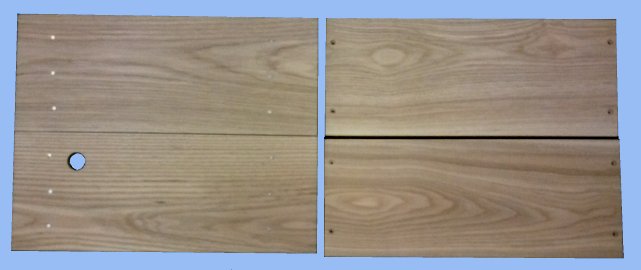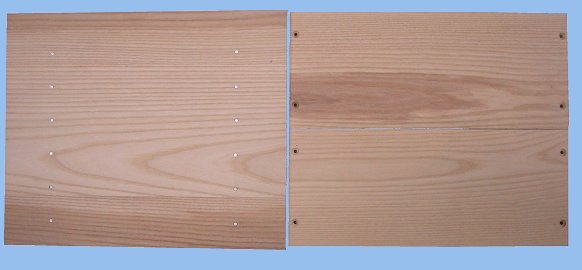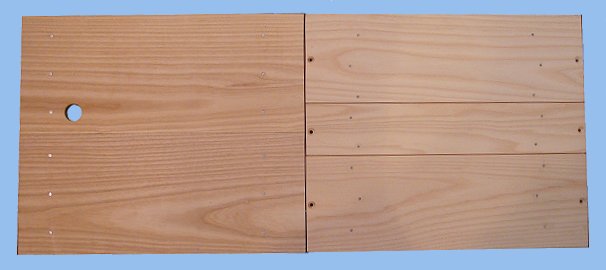
16020
1923 - 1925 Fordor Sedan Rear Floor Boards
The rear floor boards for the Fordor Sedan can be somewhat confusing. Ford numbered the floor boards from the front
to the back, starting with #1. The #1, #2 and #3 floor boards make up the front floor boards. The rear floor boards
consist of the #4, #5, #6 and #7 floor boards.
The #4 floor board runs across the width of the body and is located under the back edge of the front seat riser.
The #5 and #6 floor boards run half way across the body on the passenger's side.
The #7 floor board runs across the width of the body and is located under the front edge of the rear seat riser.
The rear floor on the driver's side is actually not a floor board, but is the battery trap door.
There were several variations of rear floor boards used in the Fordor sedan. There are no drawings for these parts, only
the Record of Change which does not give any specific information. From observation, there appears to be two variations of
rear floor boards and battery trap doors. The earlier variation has a half lap joint between the battery trap door and the
floor boards. The battery trap door fits under the floor boards. The later variation does not have this half lap joint.
Instead, the battery trap door just butts against the floor boards.
The documentation specifies that the #5 and #6 floor boards are identical. In some cars this has been observed to be the case.
In other cars, there are two boards in this location, but they are different widths. Other cars have three or even four random
width boards. It seems that they were using whatever was available and not necessarily following the documentation. These sets
will use two identical boards as per the documentation.
1923 - 1925 Fordor Sedan Rear Floor Board #4
This is the board which runs across the width of the body under the rear edge of the front seat riser. When sitting in the back seat, the board would be where your toes are.

16020
| Part Number | Description |
|---|---|
| 16020 | 24 - 25 Fordor Sedan Rear Floor Board #4 - Hardwood |
1923 - 1925 Fordor Sedan Rear Floor Board Sets
These sets consist of the #5 and #6 floor boards which make up the floor on the passenger's side, and the battery trap door which makes up the floor on the driver's side.

3626CRH3

3626CRH4
| Part Number | Description |
|---|---|
| 3626CRH1 | 23 - 24 Fordor Sedan Rear Floor Boards With half lap joint - Hardwood |
| 3626CRH2 | 24 - 25 Fordor Sedan Rear Floor Boards Without half lap joint - Hardwood |
1923 - 1925 Fordor Sedan Rear Floor Board #7
This is the board which runs across the width of the body under the front edge of the rear seat riser. When sitting in the back seat, the board would be where your heel is.

16022A
| Part Number | Description |
|---|---|
| 16022A | 23 - 25 Fordor Sedan Rear Floor Board #7 - Hardwood |
1926 - 1927 Fordor Sedan Rear Floor Boards
For the 1926 model year, Ford made some changes to the Fordor body to adapt it to the new Improved car chassis.
The new chassis has four body mounting bolts along each side instead of three. This required moving the cross member
back 4 inches, placing the new cross member in the same location as the #4 floor board on the 1923 - 1925 bodies. So while
it appears to be the same, the 1923 - 1925 bodies have a 9/16 inch thick board in this location while the 1926 - 1927 bodies
have a 1-1/4 inch thick cross member.
Since the #4 floor board was removed, Ford renumbered the rest of the boards.
The #5 and #6 boards which make up the floor on the passenger's side are now the #4 and #5 boards.
The #7 board which runs under the front of the rear seat riser is now the #6 board.
In late 1926, Ford changed to a one-piece floor board on the passenger's side. This floor board is actually made of 3 boards
held together with cleats on the bottom side. Since there is now a one-piece assembly where there were two floor boards previously,
once again Ford renumbered the floor boards.
The #4 and #5 boards which make up the floor on the passenger's side are replaced buy the one-piece #4 floor board.
The #6 board which runs under the front of the rear seat riser is now the #5 floor board.
1926 - 1927 Fordor Sedan Rear Floor Board Sets
These sets consist of the #5 and #6 floor boards which make up the floor on the passenger's side, and the battery trap door which makes up the floor on the driver's side. The early 1926 Fordor used the two pieces of wood on the passenger's side. The later 1926 - 1927 Fordors used the 'One-Piece' design.

3626CRH3

3626CRH4
| Part Number | Description |
|---|---|
| 3626CRH3 | Early 1926 Rear Floor boards Hardwood |
| 3626CRH4 | 26-27 One-Piece Rear Floor boards Hardwood |
1926 - 1927 Fordor Sedan Rear Floor Board #6
This is the board which runs across the width of the body under the front edge of the rear seat riser. When sitting in the back seat, the board would be where your heel is.

16022B
| Part Number | Description |
|---|---|
| 16022B | 26 - 27 Fordor Sedan Rear Floor Board #6 - Hardwood |
Assembly Notes
Painting
The wood parts of the floorboards should be painted with a semi-gloss black paint.
The metal trim plates should be painted with a gloss black paint.
Floor Board Brackets:
The main floorboard consists of an upper and lower piece. These two pieces were held together by three metal brackets (not included - Lang's P/N ?????) installed on the bottom side. Each bracket was attached with four #10 x 5/8 inch wood screws. See the accompanying diagram for the locations of these brackets.
Pedal Plates:
There are two pedal plates which surround the pedal openings on the #1 and #2 floorboards. These are available as Lang's P/N 3625AS (1924 - 1925) or 3625BS (1926 - 1927). There are two pedal plates which surround the pedal openings on the #1 and #2 floorboards. Prior to January of 1924, the documentation specifies these to be installed using #15 x 5/8 inch wire nails. Beginning on January 10, 1924, the pedal plates were riveted to the floorboards using four tubular rivets in each plate. When the draft deflector was added it was attached using the same rivets as the pedal plates. In practice it appears that a lot of the time (most of the time) the nails and rivets were not used. The pedal plates were simply slid over the slots and the tabs bent over to hold them in place. When the draft deflector was installed, the rivets were then used with the head of the rivet on the pedal plate and the peened side on the draft deflector.
Handbrake Plates:
A third plate is installed around the handbrake opening. It is installed using four #15 x 5/8 inch wire nails. This plate is almost the same as is used on the 1915 - 1925 open car floorboards (Lang's P/N 3633). The difference is that on the 1915 - 1925 open car floorboards the handbrake opening is contined withing the #3 floorboard which is a single flat board. On the 24-25 Enclosed cars, the handbrake opening extends across the joint of the upper and lower #3 floorboards. Since the #3 floorboard is angled, the plate also must have an angle in it. Currently the correct plate is not available, however the 1915 - 1925 open car plate can be modified to create the correct plate. The modifictaion is quite simple. Locate the location of the bend on the plate. On the back side of the plate make two small cuts in the tab, one on each side of the opening. Bend the front part of the plate upwards 30 degrees to match the angle of the #3 upper floorboard.